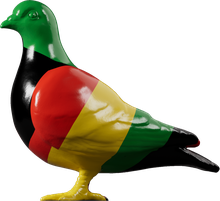Saxon & Medieval — Late Medieval; 14th-15th century
Comb
Secular badge in the form of a comb. There are several comb-shaped badges in the Museum of London collection and in other museums’ collections. Double combs like this have been thought of as symbols of St Blaise, a saint who was torn apart by iron combs in the 4th century. However, this is unlikely as the instruments of his execution would have been iron wool combs, not a hair comb like this one. Some comb badges are decorated with sexual imagery such as copulating couples or phalluses (see badge 8737), indicating that these were satirical or erotic badges. Ivory combs decorated with scenes of courtly (rather than sexual) love were given as expensive romantic gifts at this time. These cheap comb badges may be mocking this tradition or were more lewd versions. Comb badges like this may be a visual pun: the Anglo-Norman (the type of French that came to England with the Norman invasion of 1066) word for 'little comb' was 'penil', which also meant 'penis', 'pubes' or 'groin'. This pun would still have existed in the 14th and 15th centuries. This badge is plain but it may have had the same sexual connotation.
- Category:
- Saxon & Medieval
- Object ID:
- 96.99/1
- Object name:
- Comb
- Object type:
- Artist/Maker:
- —
- Related people:
- Related events:
- Related places:
- Production date:
- Late Medieval; 14th-15th century
- Material:
lead alloy
- Measurements/duration:
- H 24 mm, W 31 mm (overall)
- Part of:
- —
- On display:
- —
- Record quality:
- 100%
- Part of this object:
- —
- Owner Status & Credit:
Permanent collection
- Copyright holder:
digital image © London Museum
- Image credit:
- —
- Creative commons usage:
- —
- License this image:
To license this image for commercial use, please contact the London Museum Picture Library.

